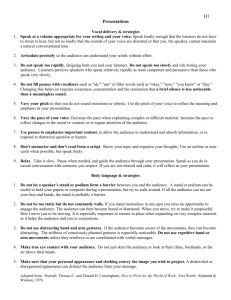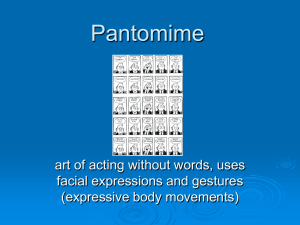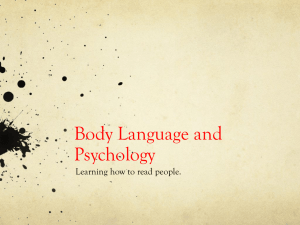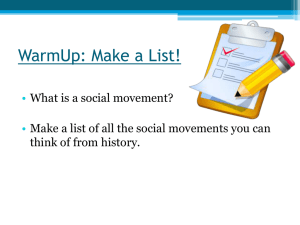Visual and Auditory Codes:
advertisement
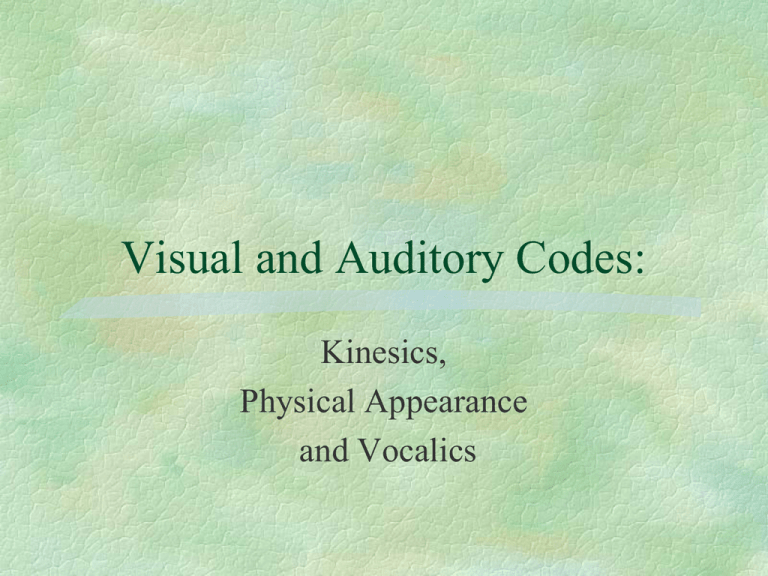
Visual and Auditory Codes: Kinesics, Physical Appearance and Vocalics Nothing is more revealing than movement. --Martha Graham The eyes of men converse as much as their tongues, with the advantage that the ocular dialect needs no dictionary, but is understood the world over. --Ralph Waldo Emerson Importance of Visual and Auditory Codes Biological survival value reflexes and other sign behavior predispositions to attend to auditory and visual social information, esp. from caregivers Developmental acquisition of speech and language Social & interactional Kinesic Code Classifications Birdwhistell kinemes kines, allokines kinemorphic constructions parakinesics Kinesic Code Classifications Ekman and Friesen affect displays adaptors (object, self, alter) • e.g., Captain Queeg’s ball bearings regulators illustrators (batons, ideographs, kinetographs, pictographs, deictic movements, spatial movements, rhythmic movements, emblematic movements) emblems (insults, greetings, departures, interpersonal directions, replies, physical states, emotions) Kinesic Code Classifications Bavelas conversational gestures • topic gestures-- ones that relate to the content itself • interactive or social gestures--ones that function to distinguish true dyadic interaction from monologues and that are nonredundant with the information conveyed by words – – – – delivery citing seeking turn-taking Kinesic Code Classifications Chovil speaker comments-- Nonrepresentational facial expressions or gestures that add in personal sentiments to neutral statements, allude to thoughts or memories, and interactive displays that recruit interlocutor’s attention listener comments-- backchannel displays, personal reactions to what speaker is saying, motor mimicry Von Cranach--gaze, mutual gaze, looks Kinesic Code Classifications McNeill & Duncan iconics-- pictorial gestures that bear a close resemblance to a concrete object that is being depicted • same as pictographs and kinetigraphs beats-- hand movements that follow the rhythmic pulsation of speech and use same form regardless of speech content deictics-- pointing gestures metaphorics-- pictorial gestures that present an abstract concept or thought process – incorporates ideographs, spatial movements, rhythmic movements, and emblematic movements cohesives-- repetitions of gestures, movements, and locations in gestural space to tie together related but separated discourse themes continuities across separated Vocalic Code Classifications Trager & Poyatos linguistic approaches primary qualities • timbre, resonance, loudness, pitch, intonation range, syllabic duration, rhythm voice qualifiers • e.g., breathing control, laryngeal control, articulatory control voice differentiators • e.g., laughter, crying, shouting, sighing, belching alternants (word-like constructions) • e.g., “pooh,” “brrr” Vocalic Code Classifications Rockwell acoustic versus perceptual classification segmentals nonsegmentals suprasegmentals Pittam functional taxonomy Norms and Expectations Illustrators Attractiveness Emblems Clothing Eye contact Hair Regulators Make-Up and Adornments Sitting & standing postures Voice tempo Voice pitch Voice quality Comparing Codes on Communication Potential Empirical evidence invalid studies valid studies conclusions Comparing Codes on Communication Potential Encoding potential number of channels available for transmission number and range of cues transmitted symbolic v. sign value simultaneity of transmission static or dynamic presentation manipulability number of functions Comparing Codes on Communication Potential Decoding potential visual and auditory acuity attention and arousal multiplicity of meanings and cultural or contextual dependency ambiguity or clarity of meanings, discernment of intent

